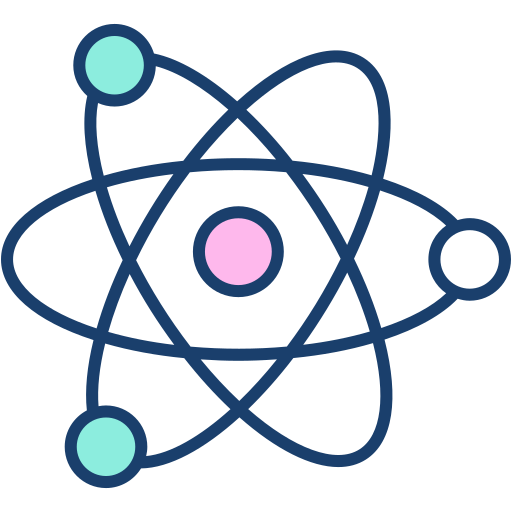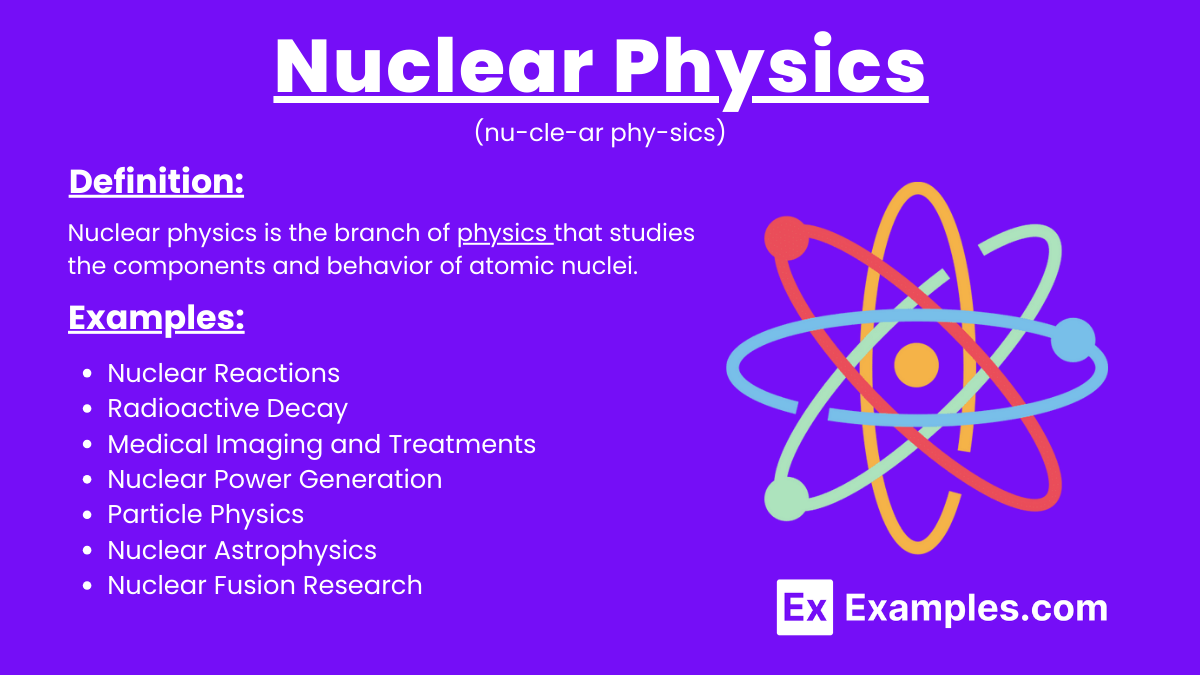What is nuclear physics primarily concerned with?
The behavior of light
The structure and behavior of atomic nuclei
The study of sound waves
The formation of planets


Nuclear physics is the branch of physics that studies the components and behavior of atomic nuclei. This field, pioneered by Ernest Rutherford, explores phenomena such as nuclear reactions, nuclear decay, and the forces that hold the nucleus together, often referred to as the laws of nuclear physics. It encompasses the study of fundamental particles like protons and neutrons, as well as the interactions and energy transformations that occur within the nucleus. Nuclear physics has significant applications in various areas, including nuclear energy production, medical imaging, radiation therapy, and understanding the fundamental principles of the universe.
Nuclear physics is the branch of physics that studies the components and behavior of atomic nuclei. It explores nuclear reactions, radioactivity, and the properties of nuclear matter. Applications include energy production, medical treatments, and advancements in fundamental science.
Nuclear reactions involve changes in an atom’s nucleus and include processes like fission and fusion. In fission, a heavy nucleus splits into smaller nuclei, releasing a large amount of energy, as seen in nuclear reactors and atomic bombs. Fusion, on the other hand, combines light nuclei to form a heavier nucleus, releasing energy, which powers the sun and holds promise for future energy sources.
Radioactive decay is the process by which unstable atomic nuclei lose energy by emitting radiation. Common types of decay include alpha decay (emission of helium nuclei), beta decay (transformation of neutrons into protons or vice versa), and gamma decay (emission of electromagnetic radiation). This phenomenon is utilized in carbon dating for determining the age of archaeological finds.
Nuclear physics has significant applications in medical imaging and treatments. Techniques such as Positron Emission Tomography (PET) scans and radiation therapy for cancer treatment rely on the principles of nuclear physics. PET scans use radioactive tracers to visualize metabolic processes in the body, while radiation therapy targets and destroys cancerous cells using controlled radiation doses.
Nuclear power plants harness the energy released from nuclear fission reactions to generate electricity. Uranium or plutonium isotopes undergo controlled fission reactions in reactors, producing heat that converts water into steam, which then drives turbines to generate electrical power. This provides a significant portion of the world’s electricity supply.
Particle physics, a subfield of nuclear physics, studies the fundamental particles and forces that make up the universe. High-energy particle accelerators, like the Large Hadron Collider (LHC), are used to investigate subatomic particles and their interactions, leading to discoveries such as the Higgs boson and advancements in understanding the Standard Model of particle physics.
Nuclear weapons are devices that release enormous amounts of energy through nuclear fission or fusion reactions. Atomic bombs (fission bombs) and hydrogen bombs (fusion bombs) are examples of such weapons. Their development and proliferation have significant implications for international security and political dynamics.
Environmental applications of nuclear physics include the study of nuclear reactions in the atmosphere and ocean. For example, scientists use isotopic analysis to trace pollution sources, understand climate change, and study the carbon cycle. Nuclear techniques also help monitor soil erosion and water resource management.
Neutron Activation Analysis (NAA) is a technique used to determine the composition of materials. By bombarding a sample with neutrons, it induces radioactivity in the elements present. The emitted gamma rays are then measured to identify and quantify the elements.
Nuclear Magnetic Resonance (NMR) is a powerful technique used to determine the structure of organic compounds. NMR exploits the magnetic properties of certain atomic nuclei. When placed in a magnetic field and exposed to radiofrequency radiation, these nuclei resonate at characteristic frequencies. This resonance provides detailed information about the molecular structure, aiding in fields like chemistry, biology, and medicine.
Nuclear astrophysics studies nuclear processes that occur in astronomical objects and events. It explains phenomena such as nucleosynthesis, the formation of elements in stars through nuclear fusion. Understanding these processes helps scientists learn about the life cycles of stars, supernovae explosions, and the evolution of galaxies, providing insights into the origin and abundance of elements in the universe.
Nuclear fusion research aims to develop a sustainable and virtually limitless energy source by replicating the sun’s fusion process on Earth. Projects like the International Thermonuclear Experimental Reactor (ITER) work towards creating controlled fusion reactions that produce more energy than they consume. Success in this field could revolutionize energy production, offering a clean and abundant energy supply.
Radiation protection and safety involve the study and application of measures to safeguard people and the environment from the harmful effects of ionizing radiation. This includes designing radiation shielding, developing safety protocols for nuclear power plants, and setting exposure limits for workers and the public.
Nuclear physics theory explores the fundamental principles governing the behavior and interactions of atomic nuclei. It provides a theoretical framework to understand nuclear forces, nuclear structure, and the mechanisms behind nuclear reactions. This field encompasses various models and theories that describe the properties and behavior of nucleons (protons and neutrons) within the nucleus.
In nuclear physics, four fundamental forces govern interactions:
Nuclear physics theory employs several models to describe nuclear structure and behavior:
Quantum Chromodynamics (QCD) is the theory describing the strong interaction, one of the four fundamental forces. It explains how quarks and gluons interact to form protons, neutrons, and other hadrons. QCD is a vital component of the Standard Model of particle physics and provides a deep understanding of nuclear matter at the most fundamental level.
Nuclear reactions involve changes in an atom’s nucleus and include processes like fusion, fission, and radioactive decay:
| Aspect | Nuclear Physics | Atomic Physics |
|---|---|---|
| Focus | Studies the nucleus of the atom (protons and neutrons) | Studies the atom as a whole, including electrons |
| Main Areas of Study | Nuclear reactions, radioactivity, nuclear structure | Electron configurations, atomic spectra, atomic structure |
| Key Processes | Fission, fusion, radioactive decay | Electron excitation, ionization, emission, and absorption of light |
| Applications | Nuclear energy, nuclear medicine, radiation protection | Lasers, semiconductors, quantum computing |
| Examples of Phenomena | Alpha decay, beta decay, gamma decay | Electron orbits, spectral lines, ionization potentials |
| Research Tools | Particle accelerators, nuclear reactors, radiation detectors | Spectrometers, electron microscopes, quantum mechanics |
| Typical Energy Scales | MeV (mega electron volts) | eV (electron volts) |
| Sub-disciplines | Nuclear astrophysics, nuclear engineering, medical physics | Quantum optics, atomic collision physics, atomic spectroscopy |
The strong nuclear force binds protons and neutrons together in the nucleus.
Nuclear fusion is the process where atomic nuclei combine to form a heavier nucleus, releasing vast amounts of energy.
Nuclear fission is the splitting of a heavy atomic nucleus into lighter nuclei, accompanied by the release of energy and neutrons.
Isotopes are atoms of the same element with the same number of protons but different numbers of neutrons.
Radioactive decay is the process by which unstable atomic nuclei emit radiation, transforming into more stable nuclei.
Geiger counters and scintillation detectors are commonly used to detect and measure nuclear radiation.
Half-life is the time required for half of the radioactive nuclei in a sample to undergo decay.
Nuclear magnetic resonance is a technique used to study the atomic nuclei by exploiting their magnetic properties.
Nuclear reactors use controlled nuclear fission reactions to generate heat, which is then converted into electricity.
Nuclear processes inside stars and supernovae are crucial for understanding stellar evolution and the synthesis of elements.
Text prompt
Add Tone
10 Examples of Public speaking
20 Examples of Gas lighting
What is nuclear physics primarily concerned with?
The behavior of light
The structure and behavior of atomic nuclei
The study of sound waves
The formation of planets
What is the basic building block of a nucleus?
Photon
Neutron
Electron
Proton
What is a neutron?
A particle with no charge
A negatively charged particle
A positively charged particle
A particle with a double positive charge
Which force binds protons and neutrons in the nucleus?
Gravitational force
Electromagnetic force
Strong nuclear force
Weak nuclear force
What is nuclear fission?
The combining of two atomic nuclei
The splitting of an atomic nucleus
The emission of radiation from an unstable nucleus
The absorption of electrons by the nucleus
Which element is commonly used as fuel in nuclear reactors?
Carbon
Uranium
Hydrogen
Helium
What is nuclear fusion?
The splitting of an atomic nucleus
The release of electrons from a nucleus
The combining of two lighter nuclei to form a heavier nucleus
The absorption of protons by a nucleus
What is a half-life in nuclear physics?
The time it takes for a substance to evaporate
The time it takes for half of the radioactive nuclei in a sample to decay
The time it takes for a nucleus to split
The time it takes for an electron to be emitted from an atom
What is a chain reaction in nuclear physics?
A series of chemical reactions
A series of nuclear reactions that sustain themselves
A reaction that occurs only once
A reaction that stops immediately
What is the role of a moderator in a nuclear reactor?
To increase the speed of neutrons
To slow down neutrons to sustain a chain reaction
To produce electricity directly
To control the temperature of the reactor
Before you leave, take our quick quiz to enhance your learning!

